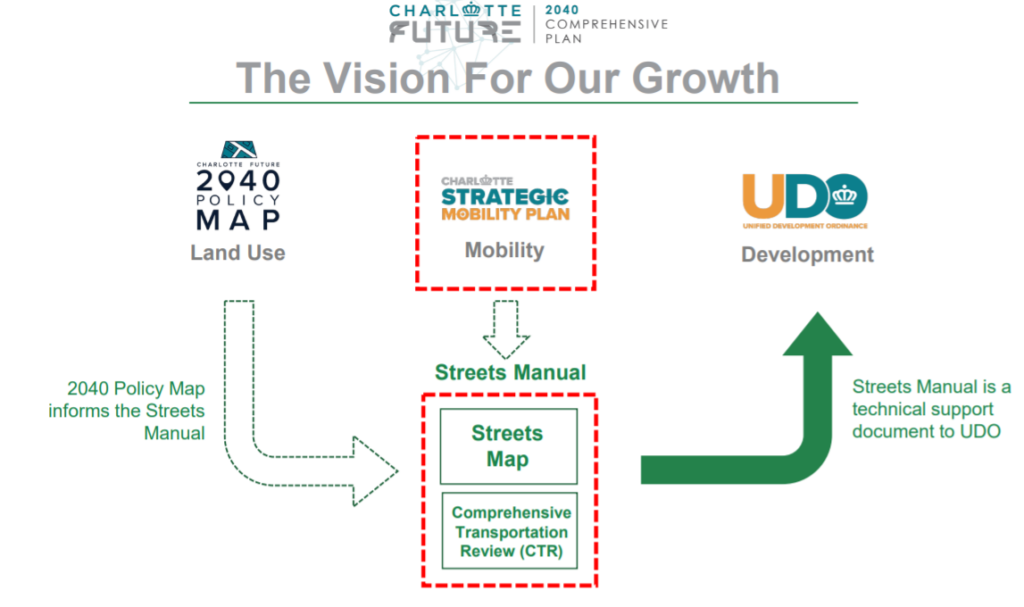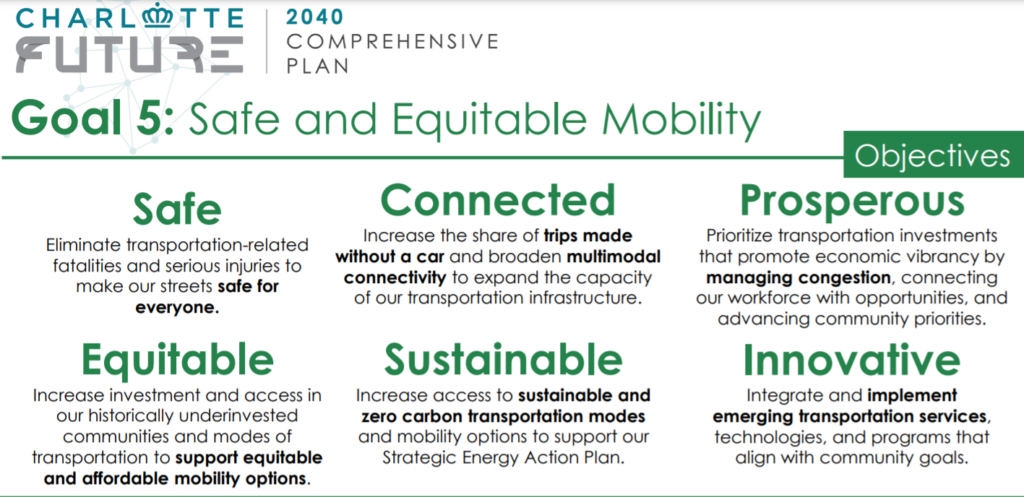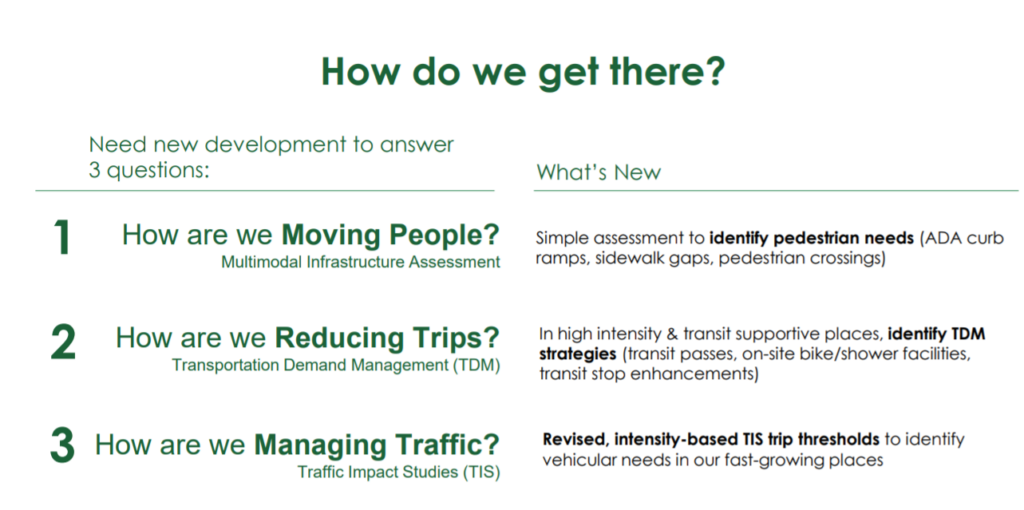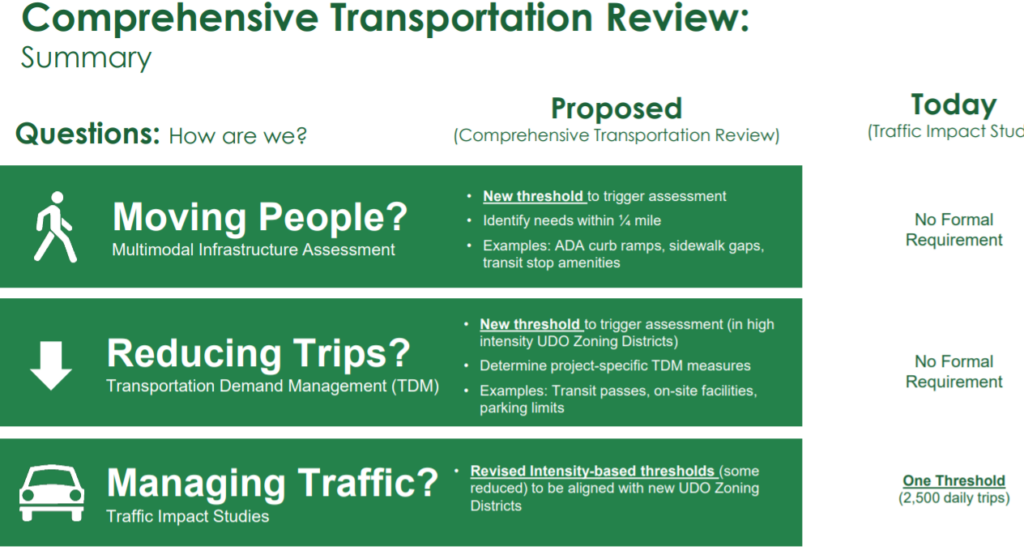Will new development guidelines make it easier to travel without a car?

The new CTR Guidelines will make it easier to walk, bike, and ride transit to new developments. (Photo: City of Charlotte)
In the absence of a robust plan to manage traffic congestion and support transportation choices, rapidly growing cities are faced with real challenges to ensure safe and time-efficient travel for everyone — whether they drive a car or get around by walking, biking, scooter, or public transit. As Charlotte’s population grows and an ever-increasing number of new buildings are constructed, how is the City planning to ensure everyone can get where they need to go?
The new CTR Guidelines will make it easier to walk, bike, and ride transit to new developments. (photo: City of Charlotte)
At the November 22nd Charlotte City Council Transportation, Planning, and Environment Committee meeting, staff from the Charlotte Department of Transportation (CDOT), shared an update to the Strategic Mobility Plan. This update primarily focused on the first draft of the Comprehensive Transportation Review (CTR) Guidelines.
Why are the CTR Guidelines Important?
The CTR Guidelines will replace the current Traffic Impact Study guidelines, incorporate new multimodal assessments, reduce trip thresholds (ie, the number of daily trips a new development is projected to generate), and support development adjacent to public transit. These guidelines consider the need for a tool to ensure mobility as by-right development happens under the new Unified Development Ordinance (UDO) zoning districts.

There are a lot of moving parts (pun intended), as you can see in the diagram above showing how the various components will be incorporated into the UDO.! The Charlotte Streets Manual, which consists of the Streets Map and the CTR, provides transportation-related technical guidance for the UDO.
Not only does the CTR serve to define a new multimodal transportation review and mitigation process for development projects, but it also focuses on multimodal investment and transportation demand management as it relates to Goal #5 of Charlotte’s Comprehensive Plan — safe and equitable mobility.

Any new development should answer these three questions. 1) How are we moving people, 2) How are we reducing trips, and 3) How are we managing traffic?
Pedestrian needs could include “ADA curb ramps, sidewalk gaps, pedestrian crossings.” TDM strategies may include “transit passes, on-site bike/shower facilities, and transit stop enhancements.” Transit Impact Studies identify “vehicular needs in our fast-growing places.”

What are the Major Takeaways?
The currently existing Traffic Impact Study process is based on vehicle trip impacts with one threshold of 2,500 trips and is primarily applied in the conditional rezoning process. For the 2040 Plan Policy, the study process will more integrative to consider the safety and mobility needs of people who walk, bike, and ride transit, as well as the overall question of traffic management.
The recently released draft CTR Guidelines will require new developments to include investments that support pedestrian safety and multimodal transportation choices. It seeks to manage traffic according to different intensities with different thresholds–low intensity and medium to high intensity. Medium to high-intensity development has a stronger focus on multimodal investments.

What do TPE Committee Members think?
Councilmember Julie Eiselt (At Large) commented on the impact of by-right development in areas such as Camden Rd, on evolving street infrastructure, and particularly on the need for bike infrastructure. She also mentioned the new idea of having a transit fund, asking new owners to perhaps pay into a transit fund to have an impact on mobility in their area.
One concern raised by Councilmember Larken Egleston (District 1) was how the City will ensure that some of the programmatic strategies such as building owners providing transit or bike share passes to tenants would not be discontinued if the building changes ownership. This is a concern that Sustain Charlotte also shares. Egleston also spoke on the need for protected bike lanes to protect cyclists from being subjected to traffic and questioned whether new programs such as providing transit passes will be offered.
Councilmember Ed Driggs (District 7) spoke on avoiding a “patchwork of compliance” and the need to join various plans together.
Councilmember Braxton Winston (At Large) mentioned that City Council works on policy, not influencing specific projects. The focus should be to have better outcomes from changes in policy.
Our take + How you can add your voice
The Comprehensive Transportation Review Guidelines are an important update to the Strategic Mobility Plan. Future development will be impacted by these updated changes in the Strategic Mobility Plan, and these tools will continue to impact planning in the City of Charlotte, for decades to come.
The Sustain Charlotte team is also working on public comments, which we’ll post to our blog soon. Overall we’re very excited because the CTR Guidelines will ensure that development occurs in a way that creates transportation solutions for the tenants and the surrounding community.
It’s essential that the guidelines do what they are intended to do. Long-term improvement in transportation equity requires long-term commitment to making it easier for people to drive less. So we think it’s important that developers invest in improvements that will remain in place throughout the lifetime of the development and not be lost if a building changes ownership or management.
The City is accepting public comments on the draft CTR guidelines through January 14th. The CTR guidelines will be revised with consideration given to community feedback, and a second draft will be released in March 2022 with mark-up displaying changes.
You can view the draft CTR Guidelines here.
Then submit your comments on the City’s UDO public input page here. The CTR Guidelines fall under the “Subdivisions, Streets & Other Infrastructure” section; Article 33.1
Thanks for reading!
As a nonprofit, community support is essential for us to keep doing what we do — including providing free articles like this. If you found this article helpful, please consider supporting Sustain Charlotte.
Want to stay in the loop? Subscribe to our weekly newsletter and follow us on Instagram, Facebook, and Twitter.
